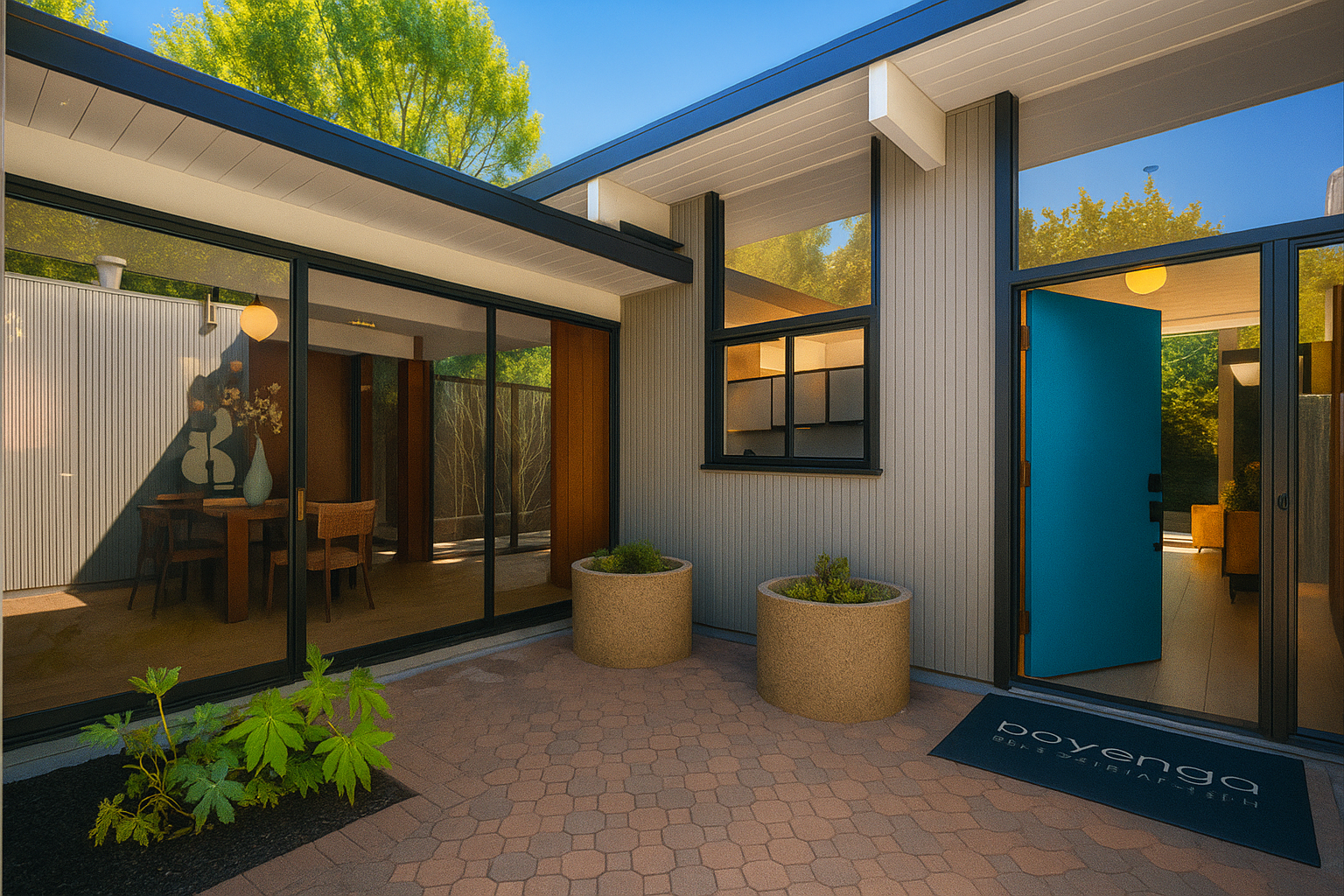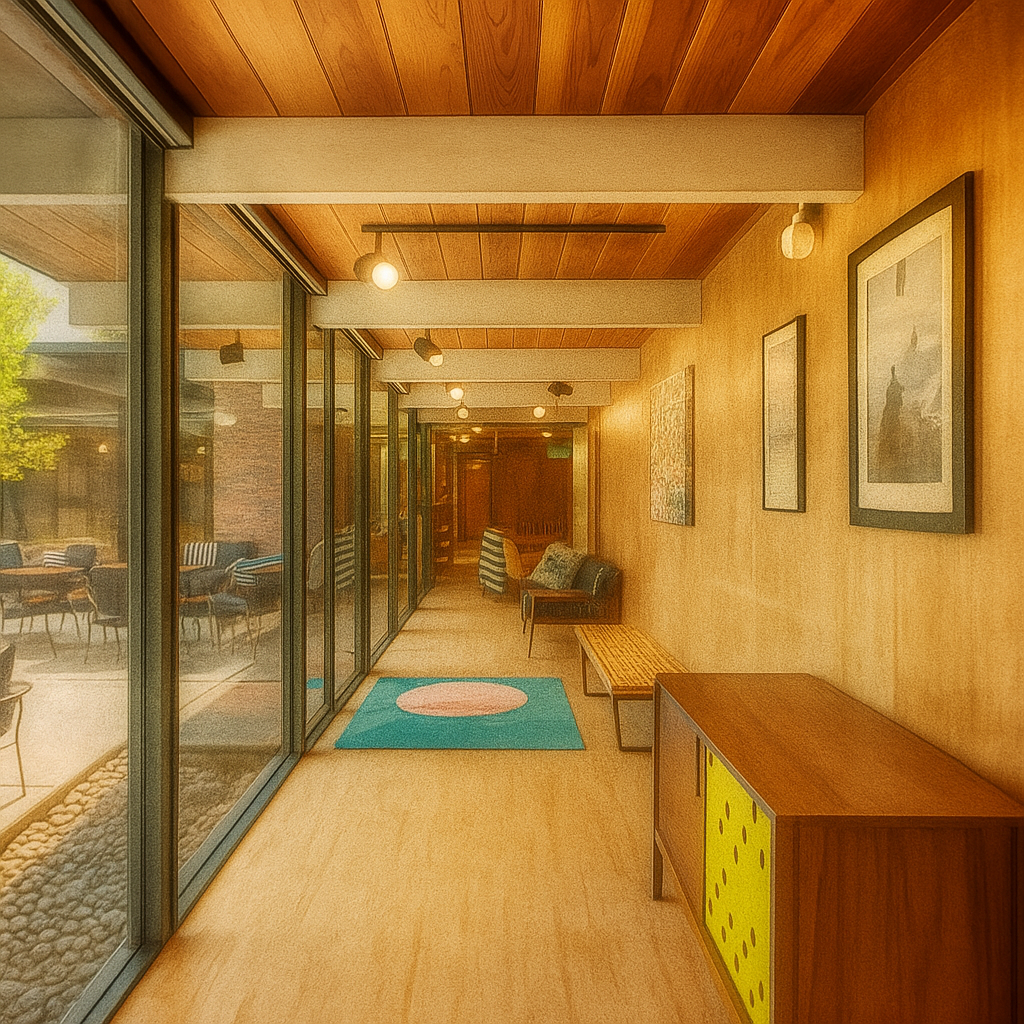The East Bay Mid-Mods — Modernism Behind the Tunnel
A New Frontier for California Modernism
Across the Caldecott Tunnel, where the fog of the Peninsula yields to golden hills and sprawling valleys, lies the East Bay’s quietly powerful chapter of Eichler history.
Here, in neighborhoods from Oakland’s Sequoyah Hills and Greenridge, to the sun-drenched tracts of Concord, Walnut Creek, and Castro Valley, the promise of post-war modernism found a second life—one shaped by topography, affordability, and a deeper connection to the Californian landscape.
The East Bay’s Eichlers represent something distinct: not just architecture, but aspiration. These were the homes for middle-class engineers, schoolteachers, and servicemen returning from World War II—people who wanted to live in beauty, openness, and community. They stand today as emblems of inclusion and innovation, and as tangible proof that good design need not be confined to elite zip codes.
For the Property Nerds of the Boyenga Team / Compass, these neighborhoods hold strategic importance: they are both living museums of design and markets of opportunity for buyers seeking architectural significance at relative value.
The East Bay Context: From Industry to Identity
While Eichler’s developments began in the Peninsula’s post-war suburbs, his East Bay ventures revealed his most ambitious social thinking. The 1950s and ’60s were transformative decades for Contra Costa and Alameda counties. Families fled the congestion of San Francisco, enticed by new highways, space, and sunshine.
Eichler seized the moment, translating his architectural ideals into the larger and more varied landscapes of the East Bay. Unlike the flatter tracts of Palo Alto or Sunnyvale, these neighborhoods hugged hillsides and creek valleys. They offered not only transparency and light but views—an architectural dialogue with the land itself.
Concord — The Democratic Dream Realized
Concord, the northeastern anchor of Eichler’s East Bay presence, represents the developer’s purest middle-class expression. Built primarily in the late 1950s and early 1960s, Concord’s Eichler tracts are modest in scale yet monumental in influence.
The neighborhoods—spread across Rancho del Diablo, Parkside, and nearby enclaves—introduced thousands of families to modernist living. These were not luxury homes; they were egalitarian design experiments.
Concrete slabs held radiant heat, clerestory windows bathed interiors in daylight, and carports replaced garages to preserve visual rhythm. Each home celebrated proportion and purpose. Even today, original Eichler models remain identifiable by their low rooflines, globe lights, and delicate interplay between solid and void.
Concord’s appeal has endured for reasons beyond architecture. The city’s affordability relative to the Peninsula has turned it into a magnet for younger families and design purists priced out of Silicon Valley. Many of these homes have been lovingly restored, blending original mahogany with solar panels, heat pumps, and sustainable landscaping.
The Property Nerds have long described Concord as “the most accessible modernist market in California”—where buyers can experience authentic Eichler living at half the cost of Palo Alto or San Mateo. For those who view architecture as a long-term equity play, Concord represents the intersection of design integrity and financial prudence.
Architecture, Geography, and the Art of Adaptation
Eichler’s East Bay projects were shaped as much by geography as by ideology. The gentle undulations of Contra Costa and Alameda counties demanded flexibility, and the architect responded not with compromise, but creativity.
Hillside lots inspired split-level innovations. Wide lots permitted sprawling atriums and deeper setbacks. The East Bay’s warmer climate allowed for greater emphasis on outdoor living, with larger patios and shading eaves. In each case, Eichler’s architects adapted form to context—a lesson that continues to inform sustainable design today.
Even in restoration, these homes invite interpretation. Architects and owners collaborate not to rebuild the past, but to extend it—adding energy-efficient glazing, passive solar elements, and contemporary kitchens while preserving the essential grammar of the architecture.
The result is a collection of homes that feel both rooted and evolving—timeless in intent, adaptive in execution.
The Market Dynamics of Modern Heritage
Eichler homes are a finite resource. No new authentic Eichlers will ever be built, which makes each property a piece of living history—and a hedge against generic development. In the East Bay, that scarcity intersects with increasing demand for architectural authenticity, producing stable appreciation curves and strong emotional liquidity.
While price points vary—from roughly $1.2 million in Concord to over $2.5 million in Oakland’s Greenridge—the common denominator is value resilience. Even during regional corrections, Eichlers tend to outperform due to their distinct identity, quality of construction, and passionate buyer community.
For investors and homeowners alike, the key is expert representation. Appraisers and conventional agents often misunderstand the architectural premium attached to Eichler homes, leading to undervaluation or suboptimal marketing. The Property Nerds correct that gap through proprietary comparative modeling and narrative-based presentation.
The Property Nerds Philosophy
At the intersection of analytics and architecture stands the Boyenga Team’s Property Nerds—a group dedicated to the intelligent representation of modern and luxury homes. Their success with Eichler properties stems from a threefold approach: fluency, precision, and storytelling.
Fluency means understanding the homes not as commodities, but as design systems—how radiant slabs work, why post-and-beam framing matters, how natural light calibrates emotion.
Precision means data: custom analytics that isolate micro-market patterns, pricing elasticity, and renovation ROI for mid-century properties specifically.
Storytelling means conveying the emotional and cultural essence of these homes—the feeling of walking through glass-filtered sunlight at noon, the quiet hum of radiant heat, the continuity between interior and landscape.
Together, these principles transform real estate transactions into acts of stewardship.
Legacy and Renewal
The East Bay’s Eichler neighborhoods endure as living proof that architecture can democratize beauty. From the family-friendly tracts of Concord to the hillside views of Oakland and Castro Valley, each home carries forward the legacy of Joseph Eichler’s conviction that design could—and should—elevate everyday life.
For buyers, these communities offer something increasingly rare: a sense of belonging through design. For sellers, they represent not merely assets, but cultural contributions. And for the Property Nerds, they remain an unending source of fascination—a field where craftsmanship meets analytics, and history meets opportunity.
Across the Bay, glass walls still glow with the evening light, atriums fill with laughter, and the dream of mid-century California modernism lives on. In these East Bay Eichlers, that dream continues—not as nostalgia, but as a blueprint for the future.
Oakland — The Hillside Modernists
The Oakland Hills contain two of the most distinctive Eichler enclaves in the region: Sequoyah Hills and Greenridge. Both express a mature, dramatic form of Eichler architecture, tailored to terrain and view.
In Sequoyah Hills, perched near Skyline Boulevard, homes cling to rolling elevations with vistas of the Bay and beyond. Built in the early 1960s, this tract demonstrates Eichler’s increasing sophistication—steeper roof pitches, multi-level entries, and an almost architectural audacity that matches the hills themselves.
Greenridge, straddling the boundary between Oakland and Castro Valley, is perhaps the East Bay’s architectural crown jewel. Developed between 1960 and 1965, it embodies what some scholars call “Eichler’s second generation”: homes that marry openness with verticality, integrating split-level designs to adapt to topography. Atriums still define entry sequences, but views and landscape integration take precedence.
Oakland’s Eichlers tell a more complex story, too—a cultural one. As one of the most diverse cities in the Bay Area, Oakland became a crucible for Eichler’s progressive ideals. Decades before inclusivity became a real estate buzzword, these neighborhoods quietly defied segregationist norms. Families of all backgrounds shared streets, parks, and architectural identity.
Today, those same values continue. Artists, academics, and technologists coexist in homes that remain deeply human—light-filled sanctuaries framed by redwoods and skyline. Market demand remains strong: renovated Eichlers often command $1.6–$2.5 million, especially those with preserved rooflines and unobstructed views.
For the Boyenga Team, these hillside Eichlers represent a convergence of architecture and storytelling—properties that require specialized marketing to translate their experiential beauty into measurable value.
Walnut Creek — The Refined Suburban Modern
If Concord was the working-class frontier of Eichler design, Walnut Creek became its suburban renaissance. Developed during the 1960s as part of Eichler’s eastward expansion, these homes occupy flat, leafy parcels near the city’s center—an area that would later become a hub for East Bay affluence and culture.
Walnut Creek’s Eichlers blend mid-century clarity with a hint of suburban sophistication. Many models feature double A-frame entries, extended eaves, and oversized glass panels. The interiors remain faithful to Eichler’s minimalist vision but with subtle upgrades in finish—testament to a clientele beginning to aspire upward.
Today, Walnut Creek’s modern tracts coexist with a bustling downtown defined by art galleries, fine dining, and the Lesher Center for the Arts. The contrast between vintage architecture and contemporary lifestyle creates a synergy unique to the East Bay.
From a market perspective, Walnut Creek occupies a fascinating niche. Its Eichlers command higher per-square-foot values than Concord but remain below comparable Peninsula prices. Their appeal spans generations—from mid-century enthusiasts seeking original craftsmanship to professionals commuting to San Francisco via BART who crave architectural meaning over mere convenience.
Sustainability and restoration play a critical role in appreciation potential here. Homes with well-preserved radiant systems, foam roofing, and period-correct renovations consistently outperform remodels that erase character. For sellers, narrative-driven marketing—something the Property Nerds excel at—is key: presenting the home not as old, but as authentically modern again.
Castro Valley — The Overlooked Gem
Nestled between Oakland and Hayward, Castro Valley is home to some of the East Bay’s most undervalued Eichlers. The community’s mid-century tracts, often attributed to Eichler’s partnerships with local builders, retain an almost time-capsule quality.
Many homes here were built on gentle slopes, giving rise to split-level and atrium hybrids that feel both intimate and expansive. Clerestory windows capture afternoon light spilling from the western hills, while carports and breezeways connect families to gardens and decks.
The Greenridge tract extends into Castro Valley’s borders, forming a seamless architectural corridor with Oakland’s hillside neighborhoods. Together they represent one of the most topographically diverse collections of Eichler design in the Bay Area.
Castro Valley’s market appeal has grown substantially in the last decade. Improved BART connectivity, excellent schools, and relative affordability have drawn a new generation of buyers—many from San Francisco and San Jose—who recognize the long-term value of design over square footage.
For the Property Nerds, Castro Valley epitomizes a rising frontier: a place where architectural significance remains attainable, where informed buyers can still shape a neighborhood’s future narrative.
Contact Us and Begin Your Mid Mod Journey Today!
Boyenga Team + Compass Eric & Janelle Boyenga 📞 Call / Text : 408-373-1660 📧 Email : Eichlers@Boyenga.com 🌐 www.BoyengaTeam.com / www.EichlerHomesForSale.com DRE #01254724 / #01254725



